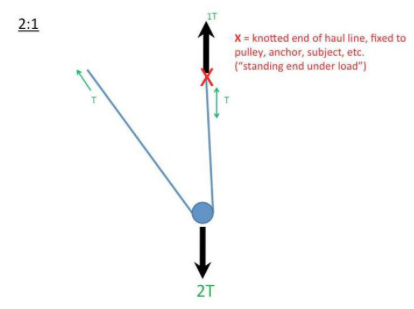An uphaul system enables a load (litter, litter bearers and patient, usually) to be raised up a slope. Conceptually, a rope can be tied to the load and rescuers can pull the load up the slope. However, the weight of a litter with litter bearers is often too large (hundreds of pounds) for a reasonable number of haulers to simply pull the load up the slope.
Uphaul systems use simple machines to gain mechanical advantage. Ropes & pulleys can be used to multiply forces by “paying” with greater distances of applied force. When forces are multiplied using simple machines, the forces on anchors can increase significantly. It is imperative to know the forces inside the systems and how they affect the anchors with which you’re working.
The diagram below is a representation of the baseline uphaul system generally employed by EPCSAR. It is discussed in more detail in the next section, “Baseline Rescue Systems”. In this diagram, the uphaul system is attached to a load line that is attached to the litter. The rest of this section discusses the uphaul systems by themselves. Uphaul systems can be used without attaching them to a separate load line, but for reasons to be discussed, it’s often advantageous to do so. In all of these diagrams, the red “X” indicates where the end of the rope in the uphaul system is fixed.
A 3-to-1 system multiplies the pulling force on the haul line by a factor of 3. When the haul team pulls with a force of 100 pounds the uphaul force on the litter is 300 pounds. In order to gain this advantage, the haul team must pull three times as far to move the litter. Pulling with 100 pounds over a distance of 90 feet, the litter will be moved under the 300 pounds applied but will only travel 30 feet. For every advantage in force, there is an inverse “cost” that you have to pay in distance.
1:1 System (a.k.a. Change of Direction)
A 1-to-1 system gives no advantage to the rescuer except a change in direction of the pulling force. For instance, it is easier to pull down to raise the load than to pull directly on the load. The forces are not multiplied and there is no “cost” to be paid in distance. Pulling on the haul line with 100 pounds equals an uphaul force of 100 pounds. Hauling 1 foot equates to 1 foot traveled by the load. Notice that the force on the anchor is twice the load.
2:1 System

A 2-to-1 system doubles the uphaul force but “costs” twice as much distance of travel for the haul team. Pulling on the haul line with 100 pounds equals a 200 pounds uphaul force. Hauling 2 feet equates to 1 foot traveled by the load. Notice that the force on the anchor is half of the load.
3:1 System
A 3-to-1 system triples the uphaul force but costs three times as much distance of travel for the haul team. Pulling on the haul line with 100 pounds equals a 300 pounds uphaul force. Hauling 3 feet equates to 1 foot traveled by the load. Notice that the force on the anchor is 66.6% of the load in a 3:1 system with no change of direction.
3:1 with Change of Direction
A 3-to-1 system with a Change of Direction triples the uphaul force but costs three times as much distance of travel for the haul team. The change of direction allows the haul team to pull opposite to the uphaul force. Pulling on the haul line with 100 pounds-force equals a 300 pounds uphaul force. Hauling 3 feet equates to 1 foot traveled by the load. Notice that the force on the anchor is 133% of the load in a 3:1 system with a change of direction. Adding the change of direction doubles the load on the anchor versus the 3-to-1 system without a change of direction.
How many haulers should be used?
It is possible to overload an uphaul system by adding too many haulers. The “rule of 12” is useful in determining how many haulers should be part of a haul team. The first diagram in this section is a good illustration of the rule of 12. If you multiply the number of haulers by the mechanical advantage, the product should not exceed 12. In the first illustration, there are four haulers and the mechanical advantage is 3; 3×4 = 12. For a 2-to-1 system, six haulers would be acceptable under the rule of 12.
The rule of 12 is a guideline. It assumes haulers who are tied into the rope and good footing. If the ground is icy, the team is pulling substantially uphill, or if other reasons reduce the force with which the haulers can pull, more people could be added. But, it should be a conscious decision to do so given the conditions.


